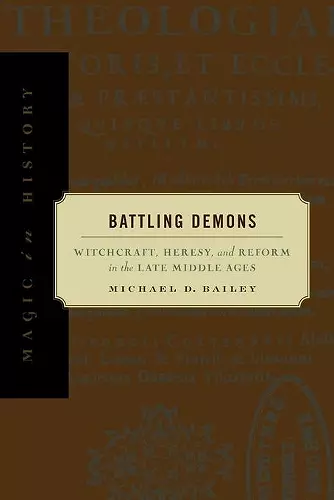Battling Demons
Witchcraft, Heresy, and Reform in the Late Middle Ages
Format:Paperback
Publisher:Pennsylvania State University Press
Published:15th Nov '02
Currently unavailable, and unfortunately no date known when it will be back

This book explores the emergence of witchcraft stereotypes in the late Middle Ages, focusing on Johannes Nider's influence in shaping these beliefs within Christian society.
During the late Middle Ages, Europe witnessed the emergence of a full stereotype surrounding demonic witchcraft, a phenomenon explored in Battling Demons. This volume centers on the Dominican theologian Johannes Nider, who played a pivotal role in shaping the beliefs about diabolical sorcery and witchcraft in the 15th century. The 1400s marked a significant period for witch persecution, a fact noted by Johan Huizinga in his classic work, Autumn of the Middle Ages. While modern perspectives often highlight the more dramatic witch hunts of the 16th and 17th centuries, it was in the preceding century that the foundational ideas about witchcraft truly took shape.
At the core of this narrative is Johannes Nider, who died in 1438. He was a Dominican theologian and reformer known for his dual role of persecuting heretics while also engaging in dialogue with them. Nider stands out as a key church authority whose writings on witchcraft were influential, including his contributions to the infamous Malleus Maleficarum, the go-to manual for witch-hunters in late medieval Europe. Although his reputation today is largely tied to his witchcraft writings, Nider was also recognized in his time for his leadership in the Dominican reform movement and for his diverse contributions to discussions on heresy and lay piety.
Battling Demons uniquely positions Nider within a broader context, illustrating that for late medieval thinkers, witchcraft represented just one element of a larger crisis affecting Christian society. As the only English-language study dedicated to the rise of witchcraft in the early 15th century, this work is essential for students and scholars interested in the history of magic, witchcraft, and medieval religious practices.
“In Battling Demons, Michael Bailey places the Dominican theologian Johannes Nider at the center of an emerging set of beliefs about diabolical sorcery and witchcraft in the fifteenth century. His argument is entirely original and will force those of us who study witchcraft to consider its implications not only for the late Middle Ages but also for the great persecutions of the sixteenth and seventeenth centuries.”
—Edward Peters, University of Pennsylvania
“Aside from offering a close reading of the Formicarius itself, the merit of this book lies in Bailey’s careful construction of the intellectual background against which he projects Nider’s assessment of the witches and the absolute evil they represented.”
—Gerhild Scholz Williams, Washington University in St. Louis The Medieval Review (TMR)
“In this masterful study of Nider, Bailey situates the Dominican reformer and his most famous work in the larger context of European religious and intellectual culture, convincingly demonstrating that the theologian’s concerns informs and shaped his understanding of [witchcraft]. By elucidating Nider’s role in fifteenth-century institutional and spiritual reform, and then connecting that reform to his conceptualization of the witch, Bailey has shed important light not only on his specific subject, but on the entire context of the early modern period.”
—J.W. Dippmann Choice
“Although the extent to which Nider was typical of his time is debatable, the book does make a valuable contribution towards integrating the origins of the idea of witchcraft into the history of the fifteenth century.”
—Helen Nicholson History
“Battling Demons is a useful and thought-provoking book. Bailey will leave his readers wanting to explore further the life and activities of Nider, his writings, and the whole history of the Council of Basel in which Nider occupied a major position. The book is scholarly enough to keep the attention of the specialist, but not so technical and intricate as to be passed over by students.”
—Jane P. Davidson Sixteenth Century Journal
“Although I suspect that more can be said about the religious status of wonders, and the pressing need to develop strategies to evaluate these, Michael Bailey has provided a thorough and compelling analysis of the origins of witchcraft.”
—Steven Vanden Broecke Renaissance Quarterly
“Bailey has written a book that should be read by everyone interested in witchcraft and late medieval religion.”
—James Given Speculum: A Journal of Medieval Studies
“Copious notes and a thorough, even though select, bibliography with an index close out this fine volume. Specialists and novices of magic, witchcraft, and heresy will find this book to be accessible, compelling and informative.”
—Alberto Ferreiro Church History
“In this valuable, accurate, and engaging volume, Michael Bailey investigates the ‘prehistory’ of the early modern concept of witchcraft through the writings of Johannes Nider, a Dominican whose fundamental treatises—in particular, the seminal Formicarius—are still ‘remarkably understudied.’”
—Armando Maggi Journal of Religion
ISBN: 9780271022260
Dimensions: 229mm x 152mm x 14mm
Weight: 340g
216 pages